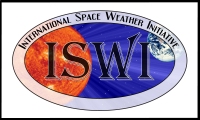The ISWI Webinar committee organizes and hosts virtual seminars on topics of interest to the community. The webinars are recorded and the playlist with the previous seminars, which will also include future sessions, can be accessed through the following links:
UN page with links: https://www.unoosa.org/
YouTube playlist link: https://www.youtube.com/playlist?list=PLaOqa4cng0GF3cKuj6Yz5kqG1BQ-Akkhr
The next ISWI Seminar will be June 26, 2024
We are pleased to announce the next ISWI Webinar by Dr. Babatunde Rabiu scheduled for June 26th, 2024 at 3 PM Central European Time (9 AM EDT; 6:30 PM IST).
To register for the virtual seminar, please send an email to: iswisupport@bc.edu. Please include “ISWI Seminar Registration” in the subject line. There is a limit of 300 participants, so please register your interest as soon as possible. The MS Teams link will be sent to registered participants 2 days before the event.
Title: Space weather activities in Africa: Capacity building, infrastructure, current research efforts and opportunities
Speaker: Babatunde Rabiu
United Nations African Regional Centre for Space Science and Technology Education – English, UN-ARCSSTE-E, Obafemi Awolowo University Campus, Ile Ife, Nigeria
Abstract:
Over the past 2 decades, two global programs initiated by the United Nations Office for Outer Space Affairs have changed the landscape of space weather research and operations in African continent for good. The programs are the International Heliophysical Year IHY and International Space Weather Initiative ISWI. The abstract compared the status of space weather before and after the two UN-endorsed programs. Majority of the 54 African nations are participating in space weather monitoring and research. Certain African nations are developing operational space weather forecast programs. IHY and ISWI programs facilitated deployment to Africa of instruments capable of monitoring space weather from 2006 to date. The list of these multiple equipment includes magnetometers, GNSS receivers, Interferometers, optical imagers among others. This paper presented the chronology of the deployment of Space Weather observational facilities to Africa during IHY and ISWI, highlighting the benefits of such programs. This paper offers a review of some recent ground breaking scientific results from the desk of African scientists including those obtained from using data obtained from ground observations in Africa. Recent development on the regional model known as AfriTEC is also presented. Available opportunities for scientific cooperation and research development are highlighted.
Speaker: Babatunde Rabiu
United Nations African Regional Centre for Space Science and Technology Education – English, UN-ARCSSTE-E, Obafemi Awolowo University Campus, Ile Ife, Nigeria
Abstract:
Over the past 2 decades, two global programs initiated by the United Nations Office for Outer Space Affairs have changed the landscape of space weather research and operations in African continent for good. The programs are the International Heliophysical Year IHY and International Space Weather Initiative ISWI. The abstract compared the status of space weather before and after the two UN-endorsed programs. Majority of the 54 African nations are participating in space weather monitoring and research. Certain African nations are developing operational space weather forecast programs. IHY and ISWI programs facilitated deployment to Africa of instruments capable of monitoring space weather from 2006 to date. The list of these multiple equipment includes magnetometers, GNSS receivers, Interferometers, optical imagers among others. This paper presented the chronology of the deployment of Space Weather observational facilities to Africa during IHY and ISWI, highlighting the benefits of such programs. This paper offers a review of some recent ground breaking scientific results from the desk of African scientists including those obtained from using data obtained from ground observations in Africa. Recent development on the regional model known as AfriTEC is also presented. Available opportunities for scientific cooperation and research development are highlighted.
